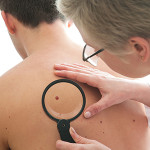Cosmetic Surgery Blog
BRCA affects men too!

When most of us think of the BRCA 1 and BRCA 2 mutations we think of women and breast cancer. However BRCA mutations can increase the risk of other malignancies including melanoma. A recent study from Israel has show that men with these mutations are also at risk. They found that men with BRCA 1 or BRCA 2 mutations were at increased risk of melanoma and pancreatic cancer as well as breast cancer, (yes men can get breast cancer too!), and unique to men is an increased risk of prostate cancer. They recommend that men with these mutations get screened for prostate cancer and that both men and women with these mutations get screened for breast and pancreatic cancer as well as melanoma.
Citation:
In one year over 50% of young adults get a sunburn!

A study from from the CDC in Atlanta examined the prevalence of sun protection use and sunburn in a 31,162 U.S. adults in 2015.
The researchers found that 34.2 % of participants experienced sunburn in 2015. The prevalence was higher among younger age groups with 51.2 % of those aged 18 to 29 years experiencing a sunburn that year.
We know that sunburns are a significant risk factor for subsequent skin cancers. As dermatologist we are clearly not doing a good enough job getting the message out. We need to better educate our youth about the risks of “unprotected sun”. Its not just to pain a discomfort of the burn itself you want to avoid but the increased risk of a skin cancer in your future.
Start educating your kids early and be a good role model with your own sun protective practices.
Article Citation:
Prevalence of Sun Protection Use and Sunburn and Association of Demographic and
Behaviorial Characteristics With Sunburn Among US Adults
Dawn M. Holman, MPH1; Helen Ding, MD, MSPH2; Gery P. Guy Jr, PhD, MPH1; et alMeg Watson, MPH1; Anne M. Hartman, MS, MA3; Frank M. Perna, EdD, PhD3
JAMA Dermatol. Published online March 14, 2018. doi:10.1001/jamadermatol.2018.0028
Botox may help surgical scars heal better!

A recent publication suggests that injecting botox around a sutured wound may allow them to heal with less scaring. The study was small, only 14 patients and the differences were not huge. However the differences were significant enough to be recognized by doctors who didn’t know which side of the scar had had botox or not.
There may be a scientific explanation for why botox would have this effect. We know that “tension” on a wound will usually lead to a thicker and/ or wider scar. That’s why we usually use deep internal sutures as well as skin sutures to minimize the tension on the skin edges as they heal. It may be that by partially paralyzing the surrounding facial muscles the botox is removing some of the tension that would otherwise effect the wound as the muscles contract. Furthermore there may be a biochemical effect. Other studies have indicated that Botox may have a direct inhibitory effects on fibroblasts and transforming growth factor-β1 expression. Both these properties could in theory lead to less scaring. More work is needed to confirm this potential use of botox, but so far its looking good. However dont expect insurance companies to be covering this any time soon!
Article Citation
Effects of Botulinum Toxin on Improving Facial Surgical Scars: A Prospective, Split-Scar, Double-Blind, Randomized Controlled Trial
Hu, Li Ph.D., M.D.; Zou, Yun M.D.; Chang, Shih-Jen M.D.; Qiu, Yajing M.D.; Chen, Hui Ph.D., M.D.; Gang, Ma Ph.D., M.D.; Jin, Yunbo Ph.D., M.D.; Lin, Xiaoxi Ph.D., M.D.
Plastic and Reconstructive Surgery: March 2018 – Volume 141 – Issue 3 – p 646–650
Not So Useful After All

Sentinel node biopsy is a procedure often used in assessing the risk posed by a melanoma. It is a method of surgically sampling the lymph nodes that the melanoma would most likely go to if it has spread. It has generally been believed that the information gained by this procedure could give the most accurate assessment of the patients chances of survival, and so help guide treatment. However a new study from the Cleveland Clinic, suggest that it may not actually add any extra prognostic information beyond the analysis of the original melanoma itself. This study suggests that the Breslow thickness of the melanoma (which is a measure of the thickness of the melanoma the pathologist will determine when analyzing the original specimen), gives as accurate prognostic information without having to go through another surgical procedure with all the risks that may involve. The decision whether or not to undergo a sentinel node biopsy is a complex one. For most early (thin), melanomas there is no benefit at all. However this study suggests that even for other melanomas the information gained may not be as useful as previously thought.
Citation
Journal of the American Academy of Dermatology
Prognostic Value of Sentinel Lymph Node Biopsy According to Breslow Thickness for Cutaneous Melanoma
J Am Acad Dermatol 2018 Feb 03;[EPub Ahead of Print], E Stiegel, D Xiong, J Ya, P Funchain, R Isakov, B Gastman, A Vij
Cover Up!

A study of the UV protection afforded by regular clothing showed that in general clothing gives better broad spectrum protection than sunscreen. You still need your sunscreen, especially for your face, but remember the easiest and often best way to protect you body and limbs is to simply cover up.
Article Citation:
Journal of the American Academy of Dermatology
In Vitro Assessment of the Broad-Spectrum Ultraviolet Protection of Clothing
J Am Acad Dermatol
2018 Jan 06;[EPub Ahead of Print], EQ Coyne, MK Lichtman, J Simons, AK Sarkar, TM Rünger
Good News Bad News about Melanoma Incidence

A research letter published in JAMA Dermatology suggested that younger patients have got the message! The rate of melanoma over the 10-year study period decreased significantly among younger white adults (men age < 45 years and women age < 35 years). Its seems that the better behavior previously observed in this cohort with regards to better sun protection and avoidance of indoor tanning is starting to show results! On the downside, the melanoma rates increased significantly among older adults (men age > 54 years and women age > 44 years). This seems to validate the importance of the mantra dermatologist have been exposing to protect your skin and your children from unnecessary ultra-violet exposure.
Table. Melanoma Incidence in White Americans (2005 to 2014)
| Age (y) | Average Rate per 100,000 | Average Change (%) | Statistically Significant |
| 15 – 24 | 3.2 | –5.1 | Yes |
| 25 – 34 | 12.1 | –1.7 | Yes |
| 35 – 44 | 20.5 | –0.5 | Yes |
| 45 – 54 | 32.4 | 0.4 | No |
| 55 – 64 | 50.4 | 1.3 | Yes |
| 65 – 74 | 82 | 2.5 | Yes |
| 75 – 84 | 109.9 | 3.6 | Yes |
| 85 | 107 | 4.6 | Yes |
Article citation
Trends in Melanoma Incidence Among Non-Hispanic Whites in the United States, 2005 to 2014
Dawn M. Holman, MPH1; MaryBeth B. Freeman, MPH1; Meredith L. Shoemaker, MPH1
Research Letter January 31, 2018
JAMA Dermatol.Published online January 31, 2018.
doi:10.1001/jamadermatol.2017.5541
Skin Cancer History Linked to Reduced Melanoma Mortality.

The results of this study of white male healthcare professionals found a surprising result.
As expected those with a history of keratinocytic cancer (basal cell or squamous cell cancer) had a greater risk of developing melanoma. However the statistical analysis of those patients who had died from melanoma vs those who had melanoma but had survived suggested that having had a prior keratinocytic skin cancer gave some protection from the subsequent melanoma being fatal. The reasoning for this is unclear and may be a statistical anomaly. However it should lead to further research to confirm these findings and see if they apply to other patient groups as well. If there is a protective effect can we gain that benefit through medications or vaccines without having the keratinocytic cancer in the first place?
Article Citation
Journal of the American Academy of Dermatology
Personal History of Keratinocyte Carcinoma Is Associated With Reduced Risk of Death From Invasive Melanoma in Men
J Am Acad Dermatol 2018 Jan 06;[EPub Ahead of Print], F Song, ST Chen, X Li, J Han
Keep it Local, Keep it Safe

A meta-analysis of over 40 studies involving almost 20,000 patients confirmed what we already know. If you have a choice, avoid general anesthesia and stick with local. They found that general anesthesia was associated with many potential risks, including life threatening risks that could be avoided with the use local anesthesia. As a side benefit the cost to patients is dramatically reduced also. Remember, whenever possible keep it local, keep it safe!
Article Citation:
Journal of the American Academy of Dermatology
Assessing the Outcomes, Risks, and Costs of Local vs General Anesthesia: A Review With Implications for Cutaneous Surgery
J Am Acad Dermatol 2018 Jan 12;[EPub Ahead of Print], MC Locke, JC Davis, RJ Brothers, WE Love
Quality of Life Matters

A recent European study examined the quality of life of patients with basal cell cancer, squamous cell cancer and actinic keratosis. They found that, while these conditions are rarely life threatening, they have a very significant impact on patients quality of life, both at the time of diagnosis and through the progression of untreated disease. They conclude that treatment of these conditions is important to improve and maintain patients quality of life, even if these conditions are unlikely be the cause of the patients ultimate demise.
Article Citation:
Journal of the European Academy of Dermatology and Venereology: JEADV
Patient-Reported Health Outcomes in Patients With Non-Melanoma Skin Cancer and Actinic Keratosis: Results From a Large-Scale Observational Study Analysing Effects of Diagnoses and Disease Progression
J Eur Acad Dermatol Venereol 2017 Nov 17;[EPub Ahead of Print], WG Philipp-Dormston, K Müller, B Novak, K Strömer, C Termeer, U Hammann, JW Glutsch, G Krähn-Senftleben, H Lübbert, M Koller, RM Szeimies
Aspirin May Improve Melanoma Survival

Previous research has suggested a potential cancer prevention benefit from daily aspirin. This new study suggests that in some patients with melanomas taking a daily aspirin may improve their overall survival. Further research is needed to confirm these findings and better elucidate who will benefit and what is the mechanism of the improved overall survival. None the less if no contraindications apply it would be reasonable for patients with melanoma to consider taking a daily aspirin.
Citation
Journal of the American Academy of Dermatology
Post-Diagnosis Aspirin Use and Overall Survival in Patients With Melanoma
J Am Acad Dermatol 2018 Jan 06;[EPub Ahead of Print], S Rachidi, K Wallace, H Li, T Lautenschlaeger, Z Li
